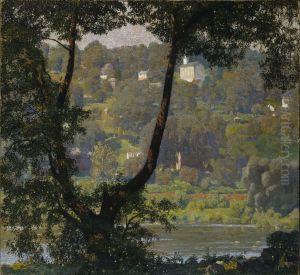Daniel Garber Paintings
Daniel Garber was an American Impressionist painter known for his pastoral landscapes and his distinctive use of light and color. Born on April 11, 1880, in North Manchester, Indiana, he moved with his family to a farm in Greenfield, Indiana, during his childhood. Garber exhibited an early talent for drawing and received encouragement to pursue an artistic education. In 1899, he began his formal art studies at the Art Academy of Cincinnati and later attended the Pennsylvania Academy of the Fine Arts in Philadelphia, where he studied under the influential American artist Thomas Anshutz.
Garber continued his education abroad in Europe, which was a common practice among aspiring American artists at the time. He studied at the Académie Julian in Paris, where he was exposed to the works of the French Impressionists, whose style would greatly influence his own.
Upon returning to the United States, Garber settled in the Pennsylvania countryside near the arts community of New Hope, becoming a central figure in the Pennsylvania Impressionist movement, also known as the New Hope School. He married Mary Franklin, a fellow artist, and they had two children. The family's home, Cuttalossa Farm, became a recurring subject in Garber's work, embodying the idyllic landscapes that he became renowned for painting.
Throughout his career, Garber taught at the Pennsylvania Academy of the Fine Arts, where he influenced a generation of artists. He was a full academician at the National Academy of Design and won numerous awards, including a gold medal at the Panama-Pacific International Exposition in 1915.
Garber's work is characterized by his vibrant palette, meticulous brushwork, and the luminous quality of his landscapes, often capturing the seasonal changes of the Pennsylvania countryside. His paintings often featured the Delaware River, local farms, and the architecture of the area, all bathed in a soft, enchanting light.
Daniel Garber passed away on July 5, 1958, in Cuttalossa. His legacy continues through his contributions to American Impressionism and his works that are held in many prominent collections, including the Smithsonian American Art Museum, the Pennsylvania Academy of the Fine Arts, and the Philadelphia Museum of Art.
